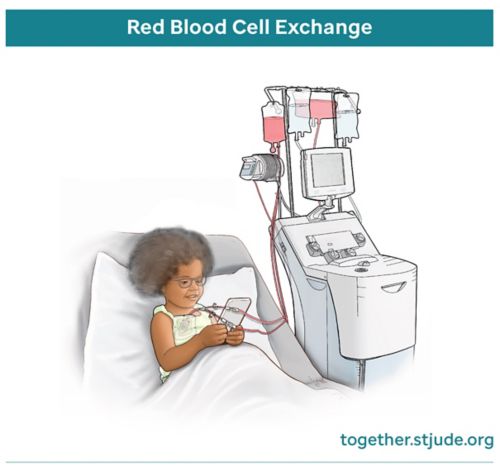What is red blood cell exchange?
Red blood cell exchange is a procedure to remove red blood cells and replace them with healthy red blood cells from a donor. It can be used to help treat sickle cell disease or other blood disorders.
Red blood cell exchange is a type of apheresis, a procedure to remove a part of the blood. An apheresis machine removes blood from your child’s vein and separates the blood into parts. These parts are plasma, platelets, white blood cells, and red blood cells. The red blood cell portion is exchanged for the donor’s healthy red blood cells and returned to your child.
Only a small part of your child’s blood is out of the body at any time. Your child’s care team determines the amount of red blood cells to remove and replace.
What to expect during red blood cell exchange
Red blood cell exchange usually takes 2–3 hours total. Your care team will explain what to expect and answer any questions.
Your child will be in bed during the procedure. Have your child wear comfortable, loose-fitting clothing. During the procedure, your child can watch a movie, read, color, or have games or toys that can be played with in the bed.
Your care team decides the best way to access your child’s veins. This is based on the size of the veins and the number of times they may need red blood cell exchange treatments. The procedure can be done with one line (single needle procedure) or 2 lines (double needle procedure).
Types of access include:
Your care team will take steps to reduce the risk of infection. All tubes that touch the blood are sterile (free from germs) and are only used once.
An apheresis nurse will stay at the bedside to monitor for any reactions or problems.
Because your child will have tubes attached to the apheresis machine, they will not be able to leave the room once the procedure has started. Portable toilet equipment will be provided if needed.
Possible side effects of red blood cell exchange
The side effects of red blood cell exchange are like those that can happen when people donate whole blood. Any side effects are usually mild and temporary. There is always the risk of rare or unknown side effects.
Side effects may include:
- Nausea
- Dizziness
- Fainting
- Pain or bruising at the site where the needle is placed
- Blood loss
- Infection
- A lower blood cell count after the procedure. This decrease is usually small. But a blood transfusion or other therapy may be necessary.
- A reaction to the blood products received during this exchange. Although not common, this may require that the procedure is stopped.
- If red blood cell exchange is stopped before it is complete, a small amount of blood may not be returned to the body.
Side effects caused by blood-thinning medicine
During red blood cell exchange, your provider may give your child a medicine called citrate. This is a blood-thinning medicine. It keeps the blood from clotting in the apheresis machine.
Citrate may cause side effects that include:
- Muscle cramping
- Numbness
- Chills
- Tingling sensations
- Strange or metallic taste in the mouth
- Feeling anxious
- Seizures (in rare cases)
The care team may give your child calcium, either by mouth or by vein, to prevent or treat these reactions.
When to contact your care team
Tell a member of your care team right away if your child has unusual sensations or discomfort during apheresis.
Contact your care team if you notice the following symptoms that may appear 24 hours to 2 weeks after the procedure:
- Blood in the urine (pee)
- Fever
- Shortness of breath
- Rash
If you have questions about your child’s procedure, talk to your care team.
—
Reviewed: November 2023




